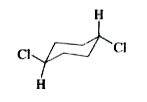Two types FXF angles are presnet in which of the following molecule (X=S,Xe,C) ? .
SF4
XeF4
SF6
CF4
The correct Answer is:A
To determine which molecule has two types of FXF angles, we will analyze the molecular structures of SF4, XeF4, and CF4.
Step 1: Analyze SF4 (Sulfur Tetrafluoride)
1. Calculate Valence Electrons:
- Sulfur (S) has 6 valence electrons.
- Each Fluorine (F) has 7 valence electrons, and there are 4 Fluorine atoms.
- Total = 6 + 4 × 7 = 6 + 28 = 34 valence electrons.
2. Determine Bond Pairs and Lone Pairs:
- Divide the total by 8: 34 / 8 = 4 (quotient) and 2 (remainder).
- Bond pairs = 4, Lone pairs = 1 (since remainder is 2, which means 1 lone pair).
3. Hybridization:
- The hybridization is sp³d (4 bond pairs and 1 lone pair).
4. Molecular Geometry:
- The shape is seesaw.
- Bond angles are approximately 120°, 90°, and 180°.
Step 2: Analyze XeF4 (Xenon Tetrafluoride)
1. Calculate Valence Electrons:
- Xenon (Xe) has 8 valence electrons.
- Each Fluorine (F) has 7 valence electrons, and there are 4 Fluorine atoms.
- Total = 8 + 4 × 7 = 8 + 28 = 36 valence electrons.
2. Determine Bond Pairs and Lone Pairs:
- Divide the total by 8: 36 / 8 = 4 (quotient) and 4 (remainder).
- Bond pairs = 4, Lone pairs = 2 (since remainder is 4, which means 2 lone pairs).
3. Hybridization:
- The hybridization is sp³d² (4 bond pairs and 2 lone pairs).
4. Molecular Geometry:
- The shape is square planar.
- Bond angles are 90° and 180°.
Step 3: Analyze CF4 (Carbon Tetrafluoride)
1. Calculate Valence Electrons:
- Carbon (C) has 4 valence electrons.
- Each Fluorine (F) has 7 valence electrons, and there are 4 Fluorine atoms.
- Total = 4 + 4 × 7 = 4 + 28 = 32 valence electrons.
2. Determine Bond Pairs and Lone Pairs:
- Divide the total by 8: 32 / 8 = 4 (quotient) and 0 (remainder).
- Bond pairs = 4, Lone pairs = 0.
3. Hybridization:
- The hybridization is sp³ (4 bond pairs and 0 lone pairs).
4. Molecular Geometry:
- The shape is tetrahedral.
- Bond angles are approximately 109.5°.
Conclusion:
- SF4 has bond angles of 120°, 90°, and 180°.
- XeF4 has bond angles of 90° and 180°.
- CF4 has bond angles of 109.5°.
- The correct answer is XeF4 (B), as it has two types of FXF angles (90° and 180°).
1. Calculate Valence Electrons:
- Sulfur (S) has 6 valence electrons.
- Each Fluorine (F) has 7 valence electrons, and there are 4 Fluorine atoms.
- Total = 6 + 4 × 7 = 6 + 28 = 34 valence electrons.
- Divide the total by 8: 34 / 8 = 4 (quotient) and 2 (remainder).
- Bond pairs = 4, Lone pairs = 1 (since remainder is 2, which means 1 lone pair).
- The hybridization is sp³d (4 bond pairs and 1 lone pair).
- The shape is seesaw.
- Bond angles are approximately 120°, 90°, and 180°.
1. Calculate Valence Electrons:
- Xenon (Xe) has 8 valence electrons.
- Each Fluorine (F) has 7 valence electrons, and there are 4 Fluorine atoms.
- Total = 8 + 4 × 7 = 8 + 28 = 36 valence electrons.
- Divide the total by 8: 36 / 8 = 4 (quotient) and 4 (remainder).
- Bond pairs = 4, Lone pairs = 2 (since remainder is 4, which means 2 lone pairs).
- The hybridization is sp³d² (4 bond pairs and 2 lone pairs).
- The shape is square planar.
- Bond angles are 90° and 180°.
1. Calculate Valence Electrons:
- Carbon (C) has 4 valence electrons.
- Each Fluorine (F) has 7 valence electrons, and there are 4 Fluorine atoms.
- Total = 4 + 4 × 7 = 4 + 28 = 32 valence electrons.
- Divide the total by 8: 32 / 8 = 4 (quotient) and 0 (remainder).
- Bond pairs = 4, Lone pairs = 0.
- The hybridization is sp³ (4 bond pairs and 0 lone pairs).
- The shape is tetrahedral.
- Bond angles are approximately 109.5°.
- SF4 has bond angles of 120°, 90°, and 180°.
- XeF4 has bond angles of 90° and 180°.
- CF4 has bond angles of 109.5°.
- The correct answer is XeF4 (B), as it has two types of FXF angles (90° and 180°).
Topper's Solved these Questions
- CHEMICAL BONDING AND MOLECULAR STRUCTUREBOOK - CENGAGE CHEMISTRY ENGLISHCHAPTER - CHEMICAL BONDING AND MOLECULAR STRUCTUREEXERCISE - Exercises Single Correct (Bond Angle)
10 Videos
- CHEMICAL BONDING AND MOLECULAR STRUCTUREBOOK - CENGAGE CHEMISTRY ENGLISHCHAPTER - CHEMICAL BONDING AND MOLECULAR STRUCTUREEXERCISE - Exercises Single Correct (Resonance And Formal Charges)
10 Videos
- CHEMICAL BONDING AND MOLECULAR STRUCTUREBOOK - CENGAGE CHEMISTRY ENGLISHCHAPTER - CHEMICAL BONDING AND MOLECULAR STRUCTUREEXERCISE - Exercises Single Correct (Dipole Moment)
16 Videos
- ATOMIC STRUCTUREBOOK - CENGAGE CHEMISTRY ENGLISHCHAPTER - ATOMIC STRUCTUREEXERCISE - Concept Applicationexercise(4.3)
19 Videos
- CHEMICAL EQUILIBRIUMBOOK - CENGAGE CHEMISTRY ENGLISHCHAPTER - CHEMICAL EQUILIBRIUMEXERCISE - Subjective type
1 Videos
Similar Questions
Knowledge Check
Which of the following molecules has longest C=C strength?
ACH2=C=CH2BCH3−CH=CH2CCH3−CH3∣C∣CH3−CH=CH2DCH3−C∣CH3=CH2Which type of symmetry is present in the following molecule ?
 APlane of symmetryBCentre of symmetryCBoth of theseDNone of these
APlane of symmetryBCentre of symmetryCBoth of theseDNone of these
In which of the following molecule in the bond angle is maximum ?
View SolutionIn which of the following molecules/ions is the bond angle largest?
View SolutionThe maximum number of reducing hydrogens are contained in which of the following molecule/s ?
View SolutionWhich of the following the molecule (s) has/have back bonding ?
View SolutionWhich type of isomerism is possible in the following two molecules ?

View SolutionThe acceptable resonating structure(s) of the following molecule is/are :

View Solution
